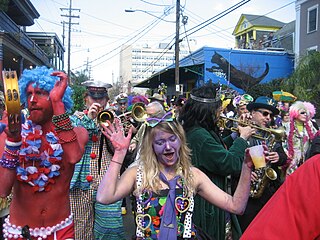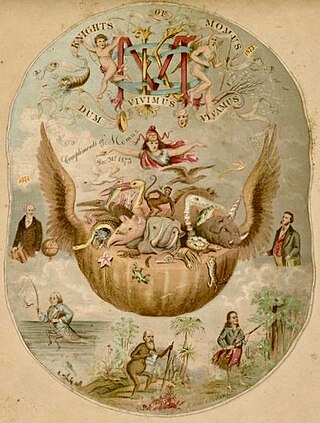KOE, formally known as the Krewe of Elvis, is a Mardi Gras parading organization that consists of members from around the world who meet in New Orleans for Mardi Gras.
KOE, formally known as the Krewe of Elvis, is a Mardi Gras parading organization that consists of members from around the world who meet in New Orleans for Mardi Gras.
1998 saw the birth of Mardi Gras' first Cyber Krewe, KOE and its members are from all over the world. Two Internet "netheads" (Craig Imboden and Chip Curley) founded it and it is made up of fellow Internet junkies devoted to Mardi Gras. KOE is a non-profit club that parades throughout the French Quarter on Fat Tuesday. There are a number of costumed marching krewes that parade through the Quarter and surrounding areas each Mardi Gras, but KOE was the first organized over the internet consisting mostly of out-of-towners who enjoyed New Orleans Mardi Gras.
KOE members regularly gather on their members page for posts and cyber chats to stay in touch throughout the year. Memberships are open to the public and currently over 150 strong.
KOE's first Lundi Gras party was held in 1999 and it remains as the official beginning of each year's KOE's Mardi Gras. The annual KOE Lundi Gras party is held Monday, the day before Fat Tuesday. Members gather at G.W. Fins restaurant to renew friendships, greet new members and trade special throws.
In 2015 the KOE began another annual tradition by hosting a members-only balcony party on the Friday Night before Mardi Gras at the Tropical Isle Bar on Bourbon Street
The KOE is known for their unique throws. Krewe members bring along beads, doubloons and trinkets to throw or hand out to the Mardi Gras crowds. Beads are always a popular throw and can be purchased at many Internet sites. Special KOE themed throws are items which Krewe members bring that support the theme that is chosen for each year's parade. In addition to the themed items, many members spend the year creating special throws which are shared with each other at the Lundi Gras party. The crowds love beads and throws and the members have fun giving them away.
KOE Theme Medallions were first created in 2004 with the Pink Cadillac. The Show Girl followed in 2005. In 2006 the KOE Pops the Big Top was a prized catch and the 2007 throw of "KOE Shakes its Booty on the 7 Seas" The 2008 theme "The West Is History" celebrated the KOE's 10th Anniversary and for the first time the parade was led by a New Orleans Jazz Marching Band. The 2009 theme was "KOE Fables and Fairytales" The KOE celebrated MG with a "HOLIDAZE" theme in 2010.In 2011 the KOE Flew high and celebrated Mardi Gras with its theme "KOE is Spaced Out" - all sorts of interesting space themed costumes were worn. 2012 the KOE marched to the theme of "Its a Jungle out there" In 2013 the KOE paraded through the streets of the French quarter with their "Barnyard Bash". In 2014, several Kings and Queens were spotted as they took on the day with the theme of "A Knight in Camelot". For their 2015 parade they channeled the Beatles theme with "Come Together". In 2016 the krewe took a wild ride down a rabbit hole with the theme "KOE in Wonderland". 2017 saw them road trip to Oz with "KOE Off To See The Wizard". 2018.....it is the KOE 20th anniversary as they commemorate this event with a throw back to an Elvis theme. Look for many Elvi parading throughout the French Quarter on Fat Tuesday.
On Mardi Gras Day, the parade starts with the Krewe gathering in front of St. Louis Cathedral in Jackson Square. The members follow a route through the French Quarter that takes them to predestined "Libation Stations" along the route. Costumes bring out the creativeness of KOE members. Each member dresses according to the theme of that year.
Details for this upcoming year (2023) will be announced shortly. Previous years saw the KOE marching parade embark on Fat Tuesday through the French Quarter on a predetermined route accompanied by the Treme Brass Band. As the members proceed throughout the streets, many revelers lined up to catch a glimpse of the outlandish costumed members hoping to catch a prized throw. Along the way they stop for TV/newspaper crews and for fans to snap photos.
As soon as the Mardi Gras is over the Captain and lieutenants begin work on the next year's theme and activities.

Mardi Gras refers to events of the Carnival celebration, beginning on or after the Christian feasts of the Epiphany and culminating on the day before Ash Wednesday, which is known as Shrove Tuesday. Mardi Gras is French for "Fat Tuesday", reflecting the practice of the last night of eating rich, fatty foods before the ritual Lenten sacrifices and fasting of the Lenten season.

A krewe is a social organization that stages parades and/or balls for the Carnival season. The term is best known for its association with Mardi Gras celebrations in New Orleans, but is also used in other Carnival celebrations throughout South Louisiana and along the Gulf of Mexico, such as the Gasparilla Pirate Festival in Tampa, Florida, Springtime Tallahassee, and Krewe of Amalee in DeLand, Fl with the Mardi Gras on Mainstreet Parade as well as in La Crosse, Wisconsin and at the Saint Paul Winter Carnival.

The Mistick Krewe of Comus, founded in 1856, is a New Orleans, Louisiana, Carnival Krewe. It is the oldest continuous organization of New Orleans Mardi Gras festivities.

Rex is a New Orleans Carnival Krewe which stages one of the city's most celebrated parades on Mardi Gras Day. Rex is Latin for "King", and Rex reigns as "The King of Carnival".

The holiday of Mardi Gras is celebrated in southern Louisiana, including the city of New Orleans. Celebrations are concentrated for about two weeks before and through Shrove Tuesday, the day before Ash Wednesday. Mardi Gras is French for Fat Tuesday, but the season actually begins on King’s Day, January 6th, and extends until midnight before Ash Wednesday. Club, or Krewe, balls start soon after, though most are extremely private, with their Kings and Queens coming from wealthy old families and their courts consisting of the season’s debutantes. Most of the high society Krewes do not stage parades. As Fat Tuesday gets nearer, the parades start in earnest. Usually there is one major parade each day ; many days have several large parades. The largest and most elaborate parades take place the last five days of the Mardi Gras season. In the final week, many events occur throughout New Orleans and surrounding communities, including parades and balls.
The Krewe of Endymion is a New Orleans Mardi Gras super krewe and social organization.

The Krewe of Orpheus is a New Orleans Mardi Gras super krewe and social organization.
Krewe of Tucks is a New Orleans Mardi Gras krewe.

Mardi Gras is the annual Carnival celebration in Mobile, Alabama. It is the oldest official Carnival celebration in the United States, started by Frenchman Nicholas Langlois in 1703 when Mobile was the capital of Louisiana. Although today New Orleans and South Louisiana celebrations are much more widely known for all the current traditions such as masked balls, parades, floats and throws were first created there. From Mobile being the first capital of French Louisiana (1702), the festival began as a French Catholic tradition. Mardi Gras has now evolved into a mainstream multi-week celebration across the spectrum of cultures, becoming school holidays for the final Monday and Tuesday, regardless of religious affiliation.
The Krewe of Muses is an all-female super krewe and social organization.

Mardi Gras throws are strings of beads, doubloons, cups, or other trinkets passed out or thrown from the floats in the New Orleans Mardi Gras, the Mobile Mardi Gras and parades all throughout the Gulf Coast of the United States, to spectators lining the streets. The "gaudy plastic jewelry, toys, and other mementos [are] tossed to the crowds from parading floats". The 'throws', consist of necklaces of plastic beads, coins called doubloons, which are stamped with krewes' logos, parade themes and the year, plus an array of plastic cups and toys such as Frisbees, figurines and LED trinkets. The plastic cups that are used as throws are sometimes referred to as New Orleans dinnerware.

A mystic society is a Mardi Gras social organization in Mobile, Alabama, that presents parades and/or balls for the enjoyment of its members, guests, and the public. The New Orleans Krewe is patterned after Mobile's Mystics. The societies have been based in class, economic and racial groups. Mobile's parading mystic societies build colorful Carnival floats and create costumes around each year's themes.

Mardi Gras in the United States is not observed nationally across the country, largely due to the country's Protestant and Anglo-Saxon roots. Mardi Gras and Carnival are mostly Catholic holidays, while the United States has a Protestant-majority population. However, a number of cities and regions in the U.S. have notable Mardi Gras or Carnival celebrations. Most of these places trace their Mardi Gras celebrations to French, Spanish, and other Catholic colonial influences on the settlements over their history. The earliest Carnival celebration in North America occurred at a place on the west bank of the Mississippi River about 60 miles (97 km) downriver from where New Orleans is today; this Mardi Gras on March 3, 1699, and in honor of this holiday, Pierre Le Moyne, Sieur d'Iberville, a 38-year-old French Canadian, named the spot Point du Mardi Gras near Fort Jackson. The earliest organized Carnival celebrations occurred in Mobile, then the capitol of French Louisiana known as Fort Louis de la Mobile, where in 1704 the first known Carnival secret society. In 1856, six Mobile natives established the first secret society, or krewe, in New Orleans, the Mistick Krewe of Comus. Former French and Spanish colonies such as Pensacola, Biloxi, and settlements along the Gulf Coast all followed suit in incorporating Carnival into their annual celebrations, which today have developed either separate traditions or variations of them from one another. In addition, modern activities generally vary from city to city across the U.S.

The Krewe of Proteus is a New Orleans Carnival Krewe founded in 1882, the oldest continuously parading Old Line Krewe.

The Intergalactic Krewe of Chewbacchus is a science fiction–themed Mardi Gras krewe, religious and parade organization, that also features fantasy and horror groups, among other fandoms. Based in New Orleans, Louisiana, as of the 2019 parade, the Intergalactic Krewe of Chewbacchus has over 2500 dues-paying members who call themselves "ChewbacchanALIENs" or "Chewbs."
Krewe of Carrollton is a New Orleans Mardi Gras krewe.

The Knights of Momus ("KoM") was founded in 1872 and was the second-oldest parading Old Line Krewe in New Orleans Carnival after the Mistick Krewe of Comus and is the third oldest krewe to continuously present a tableau ball, after the Twelfth Night Revelers in 1870.
The Mystic Krewe of Nyx is an all-female Krewe organization, based in New Orleans. Organized and founded by Julie Lea in 2011, the Nyx's first pageant, "NOLA Reality Reigns," was featured on the St. Charles Avenue Parade Route on February 15, 2012. The Mystic Krewe of Nyx is named after the Greek goddess of the night, Nyx.
Krewe of Mid-City is the 5th oldest continually-parading New Orleans Mardi Gras krewe.

Mardi Paws is a Mardi Gras procession in Covington, Louisiana dedicated to animal welfare.